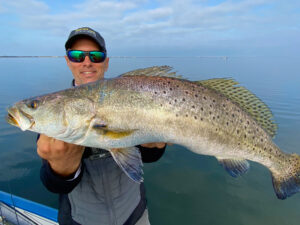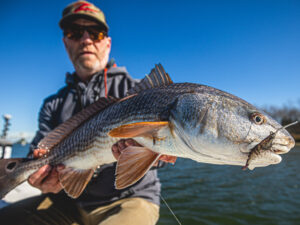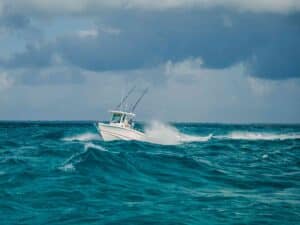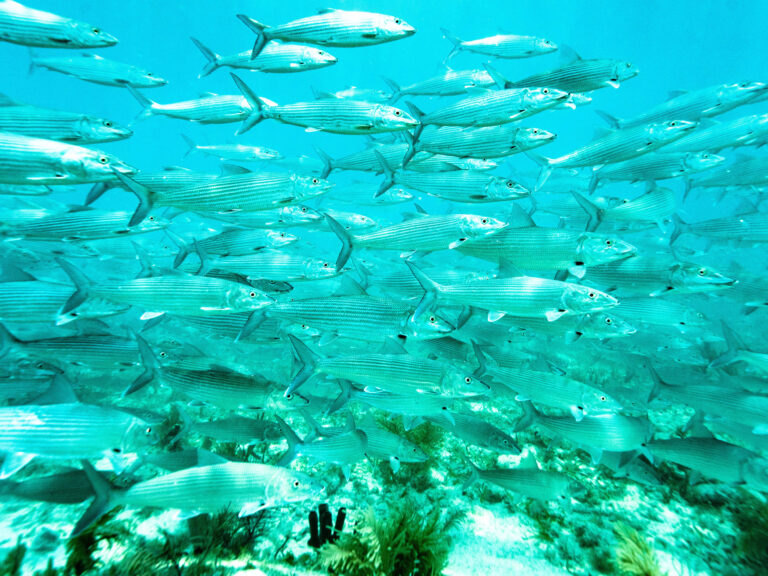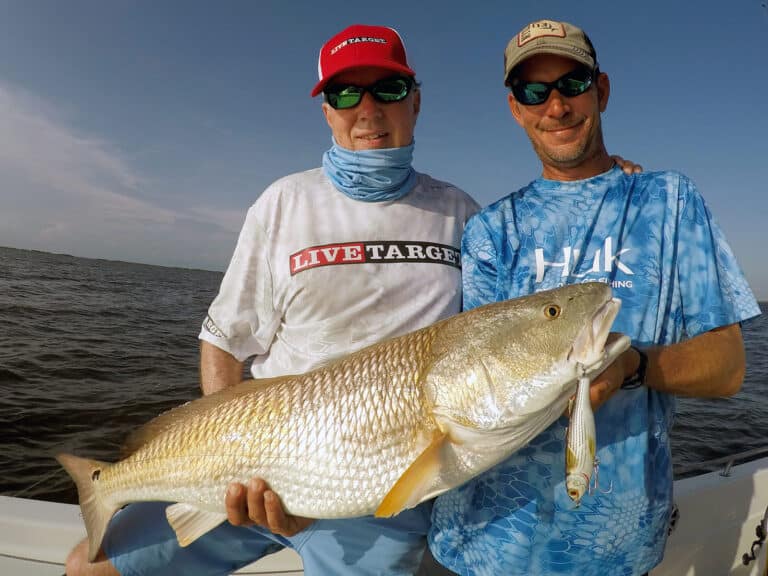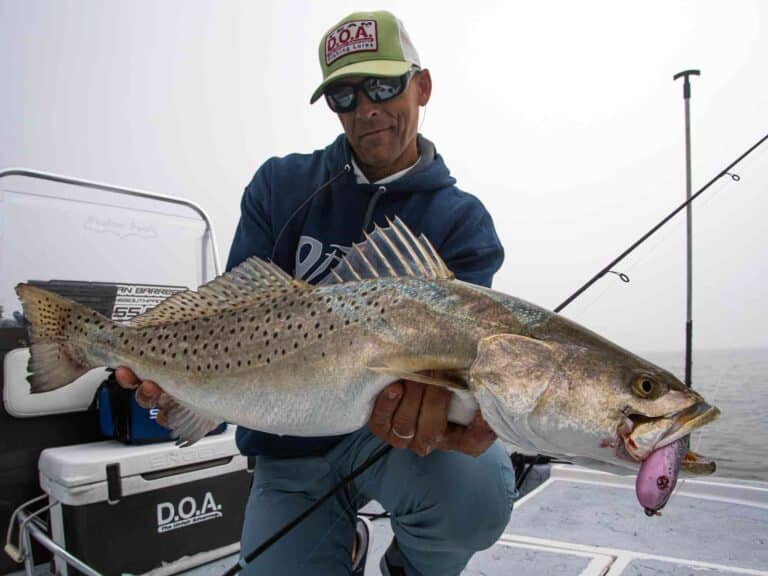In each issue of Sport Fishing magazine, a panel of five international expert ichthyologists identifies unusual and often amazing fishes in photos submitted by readers. Find out what they are and learn fascinating facts about them.
Deep in the Domain of the Domine
QUESTION:
In the southern Bahamas, while deep-dropping off Little Inagua, we caught this fish on the bottom in 1,800 feet of water. I figured if anyone would know what it is, SF’s Fish Facts experts would. Pretty cool fish, though its white meat was soft. It had fangs very similar to those of a speckled trout.
Capt. Pat Dineen
Destin, Florida

ANSWER:
Pat, your photos make a final identification a bit tricky, but based on those, it appears to be a domine, Epinnula magistralis. This rarely encountered species is quite similar to the American sackfish, Neoepinnula americana; both are members of the family Gempylidae, the snake mackerels. A primary means to distinguish the two is the original (forward area) of their lateral lines, but this is obscured by a pectoral fin here. So, it could be a sackfish. The two species’ geographical ranges overlap in the western central Atlantic. The domine is apparently much larger than the American sackfish (with reported maximums of 39 and 9 inches, respectively), and that further suggests your catch is a domine. Little life history is available for the species.
—Ray Waldner
Dolphin Disgorged
QUESTION:
We were trolling small artificial lures and catching blackfin tuna on the Islamorada Hump when one of them coughed up a few of these tiny fish. Looking closer, I noticed the forked tail and body shape. Could these be newborn mahi?
Jeffrey Dupre
Islamorada, Florida

ANSWER:
Good call, Jeffrey. It is a young dolphinfish, Coryphaena hippurus. This species is one of the fastest-growing fish in the ocean; small dolphin, such as the one you found, have the potential to grow nearly an inch every six days, but in reality, their growth rate varies considerably. Even adult dolphinfish can grow rapidly; data collected for fish in the Gulf of Mexico suggest that they can reach lengths approaching 5 feet in two years. This incredibly rapid growth corresponds with a short life span: No dolphinfish survives more than four years, and that’s a rare occurrence. Two years is likely the normal maximum age. All of this goes hand in hand with their reproductive strategy. Dolphinfish reach sexual maturity at lengths of around 20 inches, and large females can release up to 1.5 million eggs per spawn, an activity that commonly occurs multiple times each year, especially in the tropics.
—Ray Waldner
Pint-Size Snook
QUESTION:
This small snook was caught on a hand line by a local fisherman in Belize, where I fished the flats recently. I know there are several species of snook in the Caribbean; which one is this, and what can you tell me about it? How much larger than this does it grow? How many species of snook are there in all?
Dave Lewis
Dave Lewis Worldwide Fishing
Wales, United Kingdom
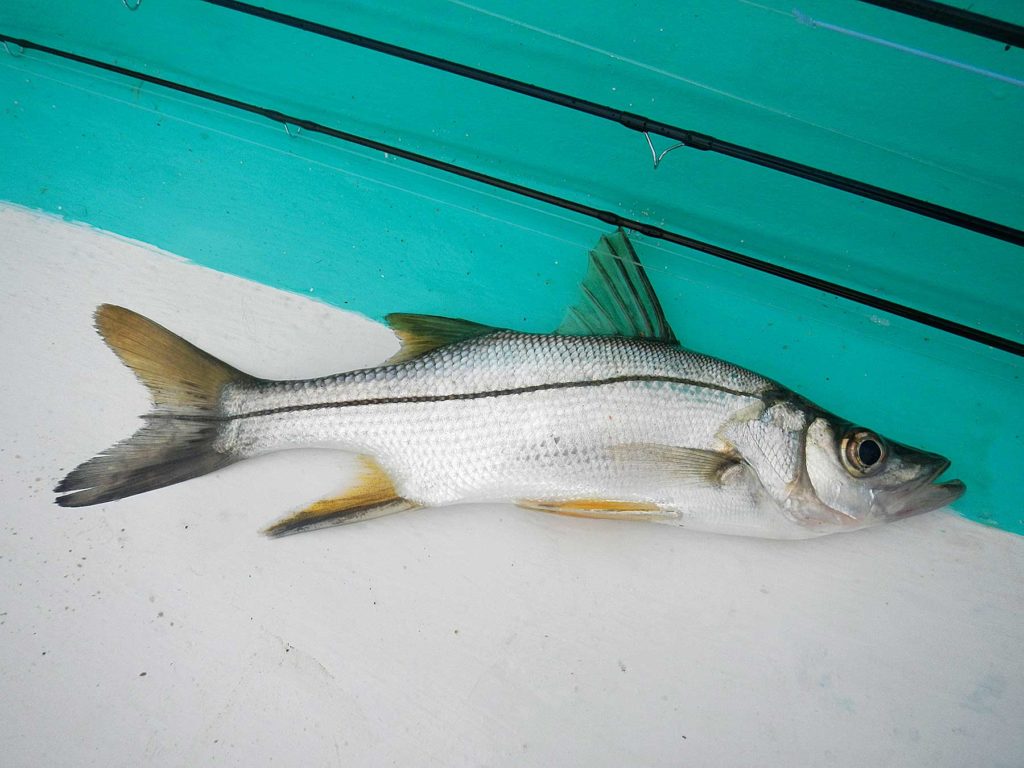
ANSWER:
The fish you photographed is Centropomus ensiferus, the swordspine snook. This species is found throughout the western central Atlantic region, ranging from South Florida to Brazil, including the greater and lesser Antilles. It can sometimes be encountered in coastal waters but prefers low-salinity or freshwater areas associated with islands. Attaining a maximum length of about 15 inches, it is the smallest of the four snook species reported from Belize and of the five species of snook known to occur in Florida. Twelve species of snook, all belonging to the genus Centropomus, are generally recognized from the Atlantic and Pacific coasts of the Americas.
—Ray Waldner
Glam Grouper
QUESTION:
My son caught this deep-dropping Hawaiian waters with cut opelu for bait on the opakapaka grounds just north of Hilo in 80 to 90 fathoms. We’ve never seen one before. Its mouth resembles a grouper’s, and the top teeth are long and curve inward. We plan to donate it to the University of Hawaii at Hilo. What did we catch?
Craig Severance
Hilo, Hawaii

ANSWER:
That, Craig, is a very interesting little fish. Because of the barotrauma from being brought up from such a depth, I found this one a little hard to identify, only being able to suggest it appears to be a member of the subfamily Anthiadinae in the family Serranidae (groupers). But when the specimen was indeed donated to the University of Hawaii, Jim Beets and Jack Randall identified it as a threadfin perchlet (Plectranthias kelloggi). This deep-sea grouper species is recorded to grow to only around 8 inches long, so your capture is pretty much as big as they get. Randall considers these fish “not rare,” but admits they’re “not often caught” by recreational anglers due to their relatively small size and the depths at which they occur. Perchlets are distinguishable from other members of the family Anthiadinae by the pale vertical stripe down the midbody, as well as the distinctive filaments on the rear of the dorsal and caudal fins. This species is known to occur in about 700 to 1,200 feet of water over rocky or sandy bottoms in several areas of the tropical central and western Pacific Ocean, including off Japan, New Caledonia and Hawaii. The fish in each of these areas are thought to be different subspecies. Stomach-content analyses suggest they feed mainly on small benthic crustaceans and finfish.
—Ben Diggles
Sport Fishing‘s Prestigious International Panel of Experts
Northeast
Mike Fahay, Sandy Hook Marine Lab, New Jersey
Southeast
Ray Waldner, Ph.D., Palm Beach Atlantic University, Florida
Gulf of Mexico
Bob Shipp, Ph.D., University of South Alabama
West Coast
Milton Love, Ph.D., UCSB, California
Far Pacific
Ben Diggles, Ph.D., Queensland, Australia
Bluewater Pelagics
John Graves, Ph.D., Virginia Institute of Marine Science

CHALLENGE OUR EXPERTS (And Win Up to 10,800 Yards of Line!)
Send in your question and any relevant photos of your mysterious catch or observation for our experts’ ID and feedback. If we publish your question and you have a shipping address within the United States or Canada, you’ll win a 3‑pound spool of Berkley Pro Spec ocean-blue or fluorescent-yellow monofilament (1,000 to 10,800 yards, depending on line strength) or a 1,500‑yard spool of Spiderwire Stealth braid up to 100‑pound‑test! Send questions and images via email to fishfacts@sportfishing.com (include your hometown) or via post to Sport Fishing Fish Facts, 460 N. Orlando Ave., Suite 200, Winter Park, FL 32789.

